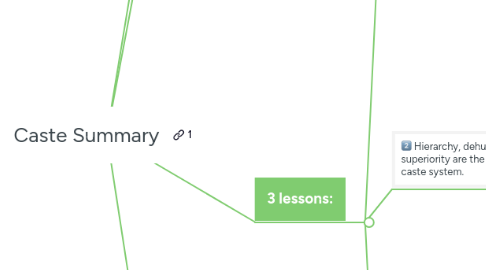
1. 1-Sentence-Summary:
1.1. Caste unveils the hidden cultural and societal rules of our class system, including where it comes from, why it’s so deeply entrenched in society, and how we can dismantle it forever and finally allow all people to have the equality they deserve.
2. Favorite quote from the author:
2.1. "The price of privilege is the moral duty to act when one sees another person treated unfairly. And the least that a person in the dominant caste can do is not make the pain any worse." - Isabel Wilkerson
3. 3 lessons:
3.1. The first four pillars of the caste system are Divine Will and Laws of Nature, Heritability, Endogamy, and Purity vs Pollution.
3.1.1. Divine Will and the Laws of Nature.
3.1.1.1. This is when religious beliefs make it hard to change the way things are.
3.1.1.1.1. In India, Hindu texts describe a caste system that places a series of groups in order.
3.1.1.1.2. Canaan – one of Noah’s three sons, is a curse to be a slave-based on the old testament.
3.1.2. Heritability
3.1.2.1. This means you are born into whatever caste your parents belong to.
3.1.2.1.1. In America, people made this pillar work by making it, so the mother’s social status determined the child’s caste.
3.1.2.1.2. This made it so children who slave masters fathered couldn’t rise in caste.
3.1.3. Endogamy and the Control of Marriage and Mating.
3.1.3.1. Endogamy which means marrying within your caste was strictly enforced, especially in US history and India.
3.1.3.2. There were times in America when a black man’s mere accusation even touched a white woman ended in lynching.
3.1.4. Purity vs Pollution.
3.1.4.1. This is when people insist on maintaining a “pure” bloodline.
3.1.4.1.1. In Nazi Germany, Jewish people are forbidden to go near any water that might touch a pure Aryan German.
3.1.4.1.2. Also, African-Americans are banned from swimming pools.
3.2. Hierarchy, dehumanization, terror, and superiority are the last four pillars of the caste system.
3.2.1. Occupational Hierarchy.
3.2.1.1. Maybe you’ve heard people claim that someone has to do the hard and menial jobs in society.
3.2.1.2. People argued that low-status jobs were for Blacks.
3.2.2. Dehumanization and Stigma.
3.2.2.1. Some groups dehumanize other groups to elevate themselves.
3.2.2.1.1. Nazis did this to the Jewish community, and America has done the same to African-Americans.
3.2.2.1.2. Blacks and Jewish people were also greatly stigmatized.
3.2.3. Terror as Enforcement and Cruelty as Means of Control.
3.2.3.1. Tragically, whippings, burnings, and hangings were things both Nazis and American slave owners did as a means of control.
3.2.3.1.1. They often did brutal whippings in full view. That can serve as a warning.
3.2.3.1.2. Hangings and burnings continued even after they abolished slavery.
3.2.4. Inherent Superiority vs Inherent Inferiority.
3.2.4.1. This is a long list of unspoken things that dominate interactions between the higher and lower castes.
3.2.4.2. Caste’s inferiority was what these expectations are meant to remind everyone, which causes lasting damage in society.
3.3. If we want to take down the caste system, we have to support those trying to destroy it.
3.3.1. A few years ago, the US had around 230 memorials commemorating Robert E Lee, the commander of the Confederate Army during the Civil War.
3.3.1.1. Despite being tolerated and even honored for a long time, people finally feel brave enough to say they should be taken down.
3.3.2. When hearings in one city were held whether to take down a statue of the general, there was some pushback.
3.3.2.1. While Nazi general Erwin Rommel was a gifted military leader, Germans didn’t erect statues. This is what Richard Westmoreland, a retired Marine lieutenant colonel, pointed out.
3.3.2.1.1. He poignantly said, “They’re ashamed. Why aren’t we?”
3.3.3. In contrast, Germany has many memorials to victims of the Nazis.
3.3.3.1. This includes markers with names on the sidewalk outside of homes from where they took them.
3.3.3.2. They humanized people.
3.3.4. But in America, merely removing a statue of a Confederate leader leads to death threats, showing how far we still have to go.
3.3.5. It won’t be simple to tackle the caste problem.
3.3.5.1. We should make people aware of its existence.
3.3.5.2. We should also support people who find ways to break free of a lower caste.
3.3.5.3. We can also highlight the things we have in common to view each other as unique individuals.
3.3.6. The more we see each other as individuals, the easier it will be to break free of castes.
